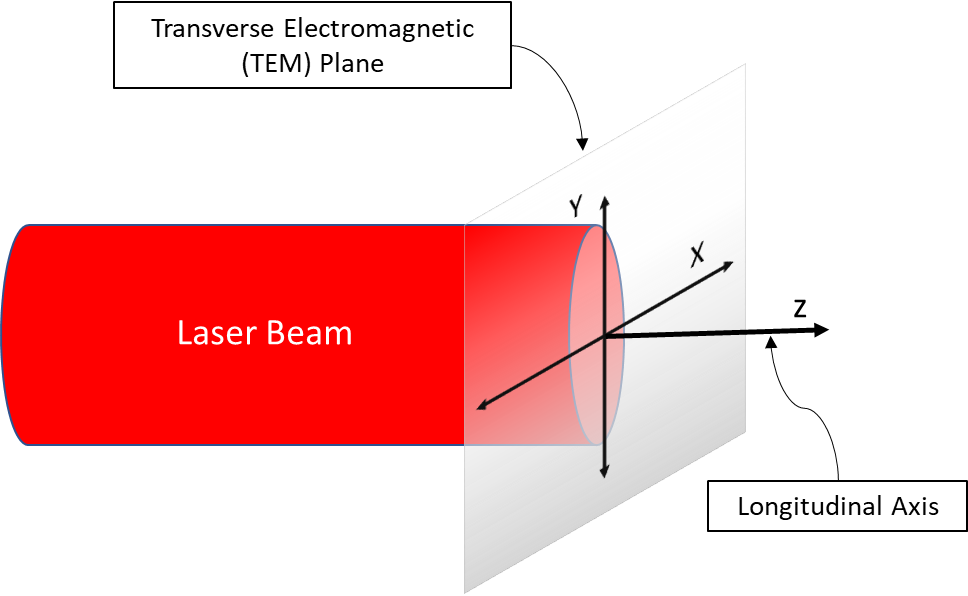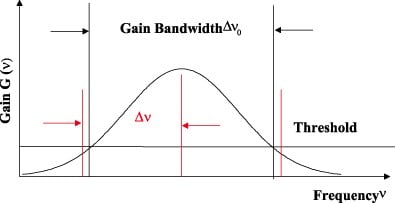
Within the laser community, one of the most overused and often miscommunicated terms is the phrase “single mode.” This is because a laser beam when traveling through air takes up a three-dimensional volume in space similar to that of a cylinder; and just as with a cylinder, a laser beam can be divided into independent coordinates each with their own mode structure. For a cylinder we would call these the length and the cross-section, but as shown in the figure below for a laser beam, we define these as the transverse electromagnetic (TEM) plane and the longitudinal axis. Both sets of modes are fundamental to the laser beam’s properties, since the TEM modes determine the spatial distribution of the laser beams intensity, and the longitudinal modes determine the spectral properties of the laser. As a result, when a laser is described as being “single-mode” first you need to make sure that you truly understand which mode is being referred to. Meaning that you must know if the laser is single transverse mode, single longitudinal mode, or both.

Most people seem to have a relatively intuitive understanding of what it means for a laser to be single transverse mode, commonly referred to as TEM00, but understanding what it means to be single longitudinal mode is often harder to understand. This is most likely because unlike the TEM mode structure, which you can physically see when you look at the beam profile, the longitudinal mode structure instead affects the spectral properties of the laser, which aren’t as directly observable. To really understand the longitudinal mode structure of a laser beam first you need to take a step back and think about how standing waves function inside of a resonator.
Whenever a wave has two fixed points, whether it is the mirrors in a laser cavity or the ends of a guitar string, the frequencies that the wave can vibrate at are solely dependent on the length of the cavity. This process is illustrated in the figure below showing the fundamental frequency and the first two overtones for a cavity of length L. If you extrapolate this out, it is easy to understand that while there are an infinite number of frequencies that can exist within the cavity, each one will have a discreet spacing between them which is dependent on the geometry of the cavity.

Therefore, along the longitudinal axis of the laser beam, the mode structure will determine the laser’s frequency content, and as a result, its spectral properties. A detailed explanation of the physical phenomenon behind which modes will be stable for a given laser is beyond the scope of this blog, but if you would like to take a deep dive into the subject matter you should check out our previous blog post titled “Laser Diode Fundamentals: Single Longitudinal Mode Diodes.” For the sake of this analysis we will simply state that in a laser system any longitudinal modes that are within the gain band and above threshold will lase, as shown below.
If more than one mode is above threshold the laser is said to be a multi longitudinal mode laser, and only when just one mode is above threshold it is considered a single longitudinal mode laser. Single longitudinal mode lasers are ideal for any application where narrow linewidth and or precise knowledge of the laser’s wavelength is needed since it is the only case in which there is only one fundamental frequency component to the laser’s spectrum. As a result, single longitudinal mode lasers are also commonly referred to as single-frequency lasers, but it is vital to take note that they are not genuinely single frequency. These lasers will still have a defined spectral linewidth, which results from a combination of the gain medium’s line shape function and the reflectivity of the mirrors in the laser cavity. But that being said, the linewidth of a typical single longitudinal mode laser is often narrower than most optical spectrum analyzers are capable of resolving, so it is safe to assume for most applications that single longitudinal mode lasers are also single frequency. The only exception is when the application requires extremely long coherence lengths, such as interferometry and holography.
If you would like information on any of the wide variety of single longitudinal mode lasers we offer here at RPMC, click here, or talk to one of our laser experts today by emailing us at [email protected] or by clicking the button below!
Have questions?

 BUY NOW
BUY NOW 